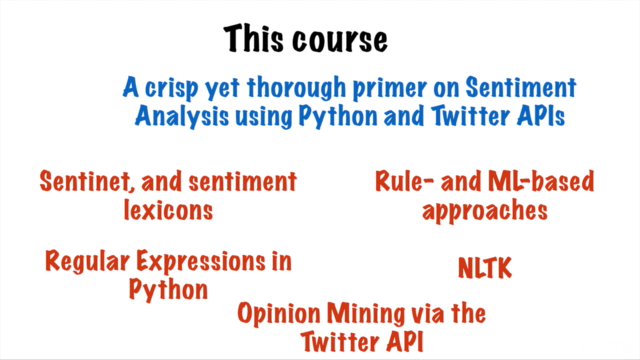Byte-Sized-Chunks: Twitter Sentiment Analysis (in Python)

Why take this course?
🌟 Course Title: Byte-Sized-Chunks: Twitter Sentiment Analysis (in Python)
🚀 Course Headline: Use Python and the Twitter API to build your own sentiment analyzer! 🚀
Note: This course is a condensed version of our comprehensive 'From 0 to 1: Machine Learning & Natural Language Processing' course, so if you're planning to dive deeper into those topics, sign up there instead! 😊
🎉 What is Sentiment Analysis? Sentiment Analysis, or Opinion Mining, is a fascinating field within Natural Language Processing (NLP) that involves detecting and classifying opinions expressed in text to determine the subjective information contained within an entire body of text. 📊
🔍 Course Description: In this course, you'll embark on a journey through the realm of sentiment analysis using Python and the Twitter API. We'll explore why sentiment analysis is a valuable tool for understanding public opinion and how to tackle its challenges. From selecting appropriate approaches, such as Rule-Based or Machine Learning (ML)-Based methods, to the critical steps of training data preparation and feature extraction, you'll learn to utilize Sentiment Lexicons and Regular Expressions to enhance your analysis.
Key Topics Covered:
-
Understanding the Importance of Sentiment Analysis: We'll delve into why it's an essential skill for marketers, political strategists, customer service managers, and anyone looking to understand public perception.
-
Approaches to Solving Sentiment Analysis:
- Rule-Based Methods: These are the first methods to be deployed in sentiment analysis tasks and involve the use of predefined rules for identifying sentiment in text.
- ML-Based Methods: We'll explore how Machine Learning models can be trained to recognize sentiment more accurately over time.
-
Training & Feature Extraction: The nuts and bolts of sentiment analysis, where we discuss the importance of high-quality training data and feature extraction for building robust models.
-
Sentiment Lexicons: Discover how lists of words categorized by sentiment can be leveraged to create a foundational set of features for your sentiment analyzer.
-
Regular Expressions: Get hands-on with regex, a powerful tool for text processing, which is crucial when dealing with the diverse and abbreviated nature of tweets.
-
Twitter API & Sentiment Analysis of Tweets: Learn to navigate the Twitter API to collect tweet data and apply your sentiment analysis skills to process and analyze the sentiment of users on Twitter.
By the end of this course, you'll have a solid understanding of how to perform sentiment analysis on social media data, specifically from Twitter, using Python. You'll be well-equipped with the knowledge and tools needed to extract insights from user-generated content and make informed decisions based on sentiment trends. 🚀
So, are you ready to tap into the world of public opinion and learn how to analyze sentiment with Python? Let's get started! 🎉
Course Gallery




Loading charts...